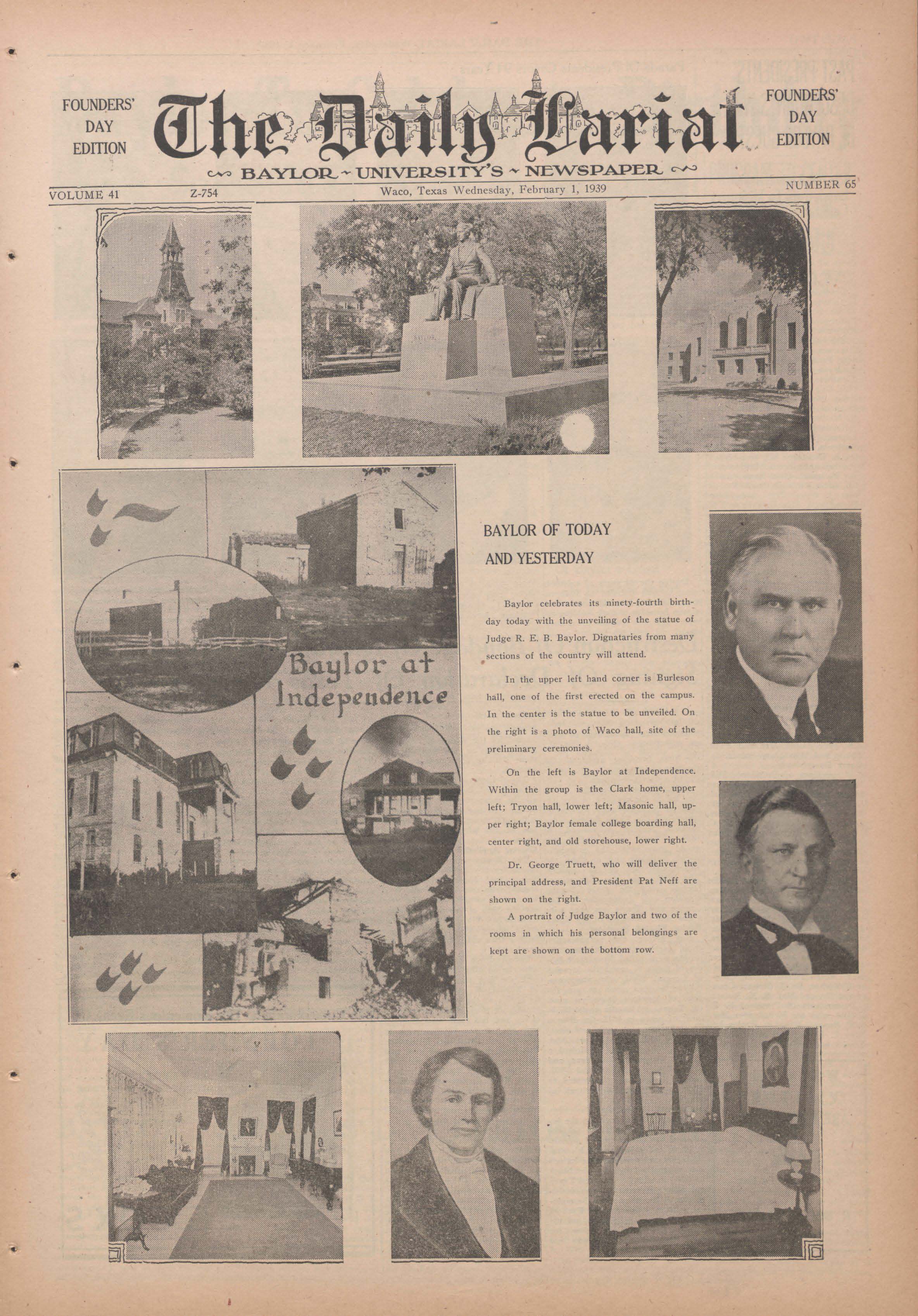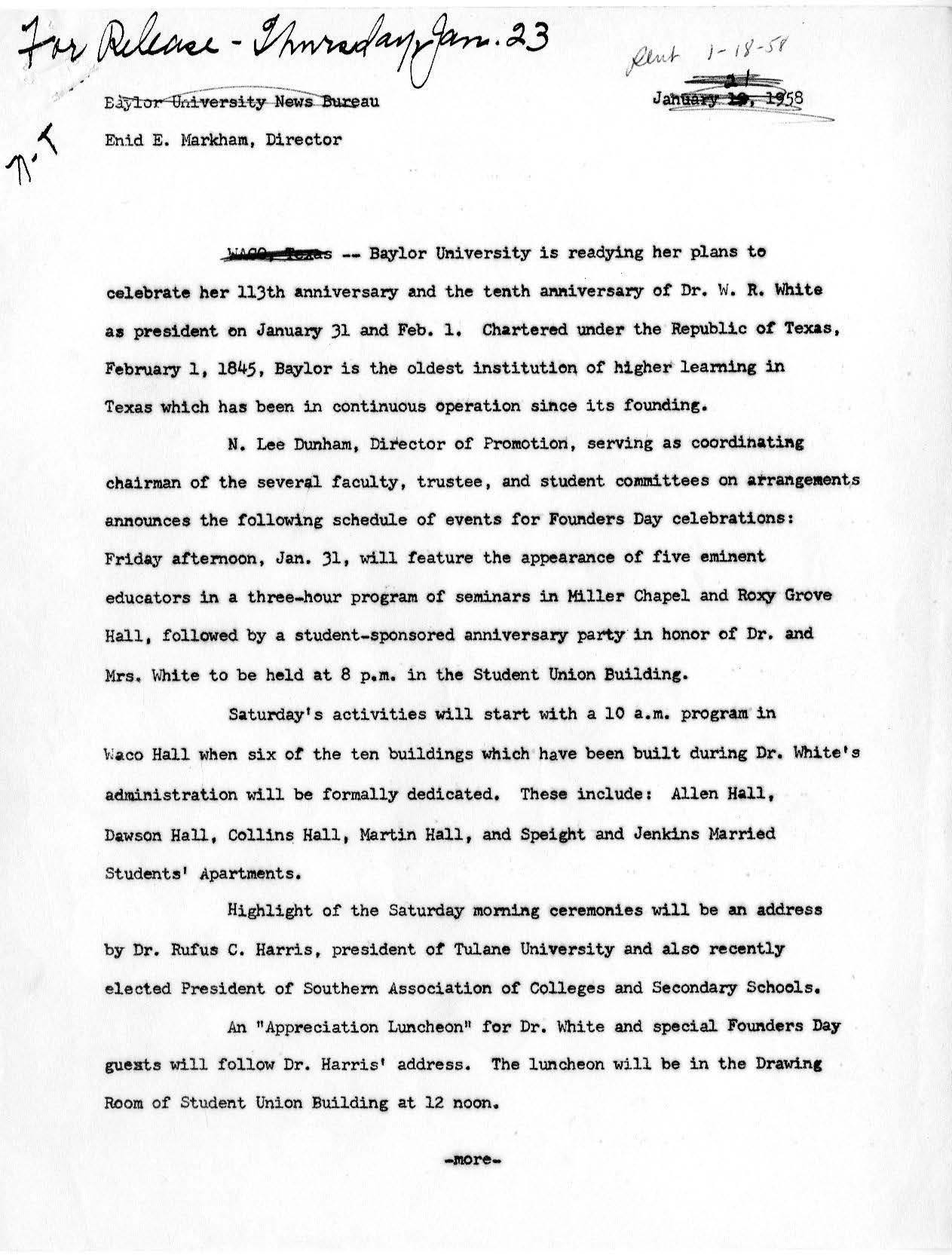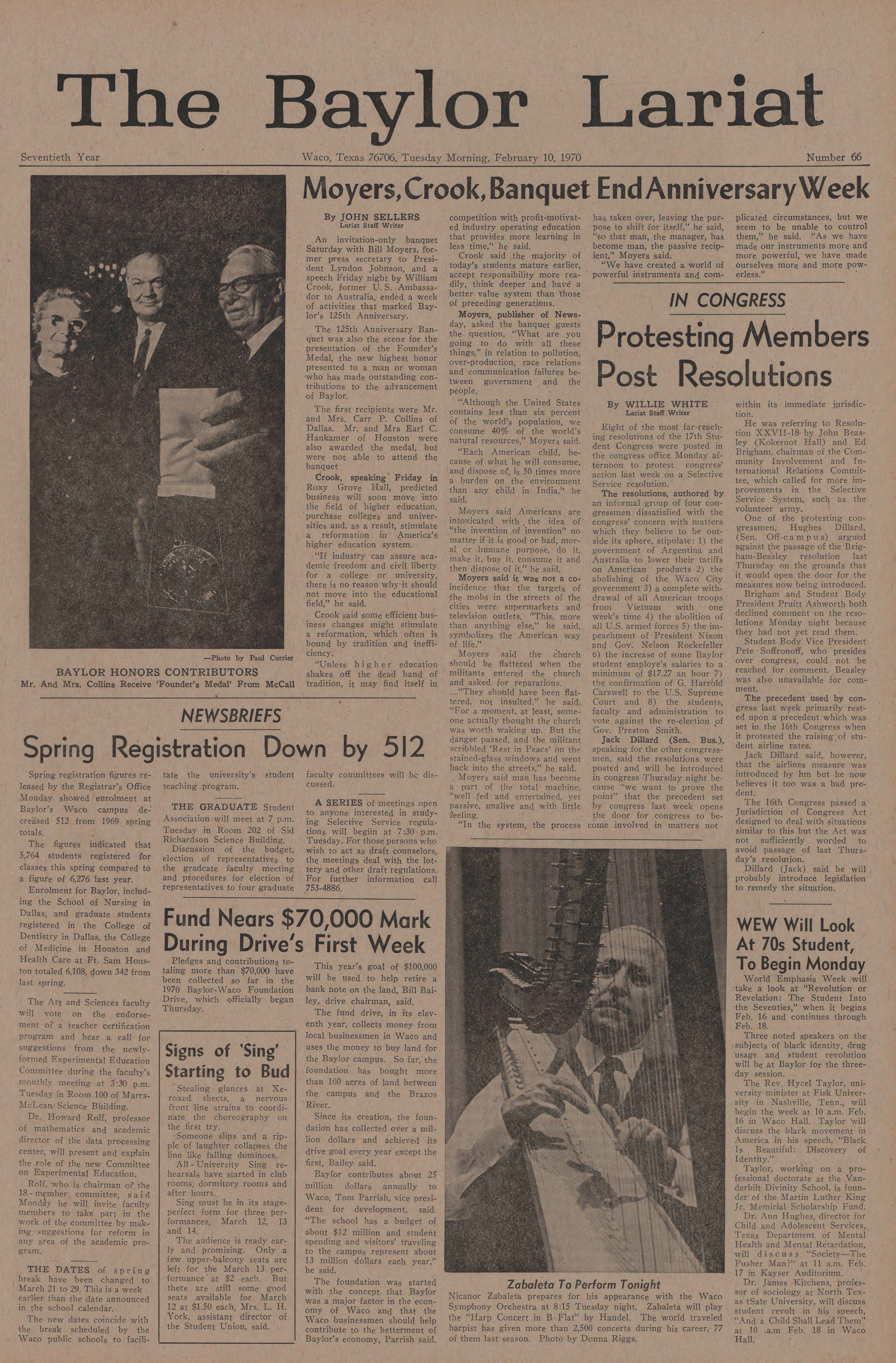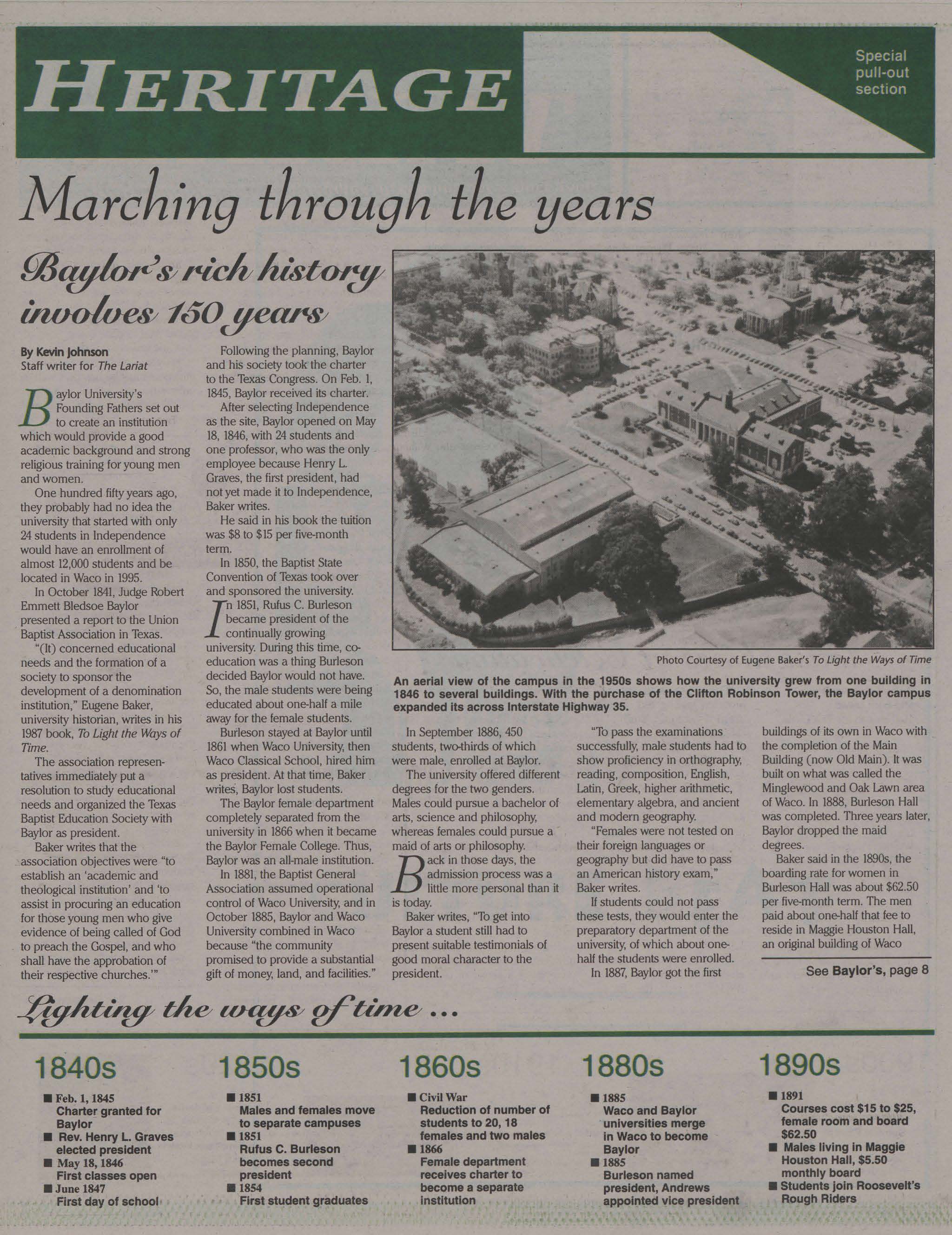
Today marks the 171st anniversary of the signing of Baylor University’s charter. On February 1, 1845, Republic of Texas President Anson Jones signed the Act of Congress that established our institution. Happy birthday, Baylor!
From the beginning, Baylor has enjoyed looking back at its history, as evidenced by many publications, features in the Lariat and Round Up, class projects (such as the HESA Baylor history blog—more on that in a future post), and the traditions that help link our past with our present. But in the 1920s, Baylor started to celebrate more officially the anniversary of its founding. By searching in our digitized Lariats and press releases, we highlighted key Founders Day celebrations throughout the twentieth century. Enjoy!
In 1923, we see the first mentions in the Lariat of Founders Day festivities (see above). That year, the university did a radio broadcast of a program featuring speeches by President Samuel Palmer Brooks, Dr. Kenneth Hazen Aynesworth (whose donation that year would found The Texas Collection), and few other Baylor alums and supporters. The broadcast was heard as far away as Kansas! President Brooks touts that Baylor “is a real University now,” having ceased its preparatory program and with Schools in everything from sciences to music to law to medicine. He concluded his portion by reminding alumni that “our object in life is the betterment of mankind.” Read more in the February 3, 1923, Lariat.

1939 brings the unveiling of the new Judge R.E.B. Baylor statue. You can read more in a past blog post about the process of funding and selecting the artist for this public art piece. In addition to hosting Judge Baylor’s descendants, the university invited to campus descendants of all of Baylor’s past presidents, along with other dignitaries. The sculptor, Pompeo Coppini, who also was the artist behind the Rufus C. Burleson statue, was awarded an honorary doctorate in 1940, in recognition of his work for Baylor and the state of Texas. Read more in the February 1, 1939, Lariat.
Baylor celebrated its 100th anniversary in 1945, with a year-long theme of “Christian Education: Safeguard of Democracy.” The university rolled out the red carpet, despite the ongoing war: honorary degrees were bestowed, the pillars dedicated to William Tryon and James Huckins (by the Judge Baylor statue) were unveiled, exhibits were on display, and campus tours were offered. A concert by the Baylor Symphony Orchestra wrapped up the Founders Day festivities, featuring the “Centennial Overture” written by Dean Daniel Sternberg especially for the occasion. Read more in the February 1, 1945, Lariat.

The tenth anniversary of W.R. White’s presidency was commemorated in conjunction with Founders Day in 1958. In addition to a three-hour program of lectures by “eminent educators” and a student-sponsored party in honor of Dr. and Mrs. White, the university dedicated six of the ten buildings constructed during White’s presidency to date: Allen, Dawson, Collins, and Martin Halls, and Speight-Jenkins Married Students’ Apartments. (Can you tell that housing was an important need during White’s presidency?) But, construction is never done on a college campus: White announced on Founders Day the naming gift that started the Marrs McLean Science Building project. Read more in the January 18, 1958 press release, and the February 4, 1958, Lariat.
In 1966, the Lariat called out the University for the lack of Founders Day celebration! In the 1960s, there were some Founders Day activities, such as the 1964 dedication of Marrs McLean…but sometimes, as the article notes, it was left up to ex-student clubs to celebrate on their own. The relatively new Baylor/Waco Foundation also timed their annual fund drive kickoff to coincide with Founders Day. Read more in the February 3, 1966, Lariat.

The Founders Medal was introduced in 1970, which also marked Baylor’s 125th anniversary. The Founders Medal still is one of Baylor’s highest honors, presented to men and women who have made unusually significant contributions to the life of the University. The first recipients were Mr. and Mrs. Carr P. Collins and Mr. and Mrs. Earl C. Hankamer. (Misters Collins and Hankamer both were longtime Baylor Trustees and supporters.) Read more in the February 10, 1970, Lariat.
In 1986, Baylor celebrated the centennial of the Waco campus. (There is no shortage of significant anniversaries for Baylor to commemorate!) The James Huckins Baylor Founders Day Award (not the Founders Medal, but we’re unsure what the distinction was for this award) was presented to Dr. Guy Newman, a Baylor alumnus who was at the time president emeritus of Howard Payne University. Also part of Founders Week was the debut of the Baylor-Waco Centennial Anthem, “The Lord Reigneth,” composed by Richard M. Willis, professor and composer-in-residence, by the A Cappella Choir. Read more in the February 5, 1986, Lariat.

Baylor’s Sesquicentennial year was 1995, a particularly significant anniversary that brought a year’s worth of celebrations. For Founders Week, the Lariat included a special pull-out section on Baylor’s heritage, complete with timeline of important events and articles on various aspects of the University’s history. The sesquicentennial time capsule was buried on Founders Day, with submissions invited from seniors wanting to leave their mark. The capsule will be opened in 2045. Read more in the February 3, 1995, Lariat.
The Founders Medal now is conferred at Homecoming, along with Baylor’s other Meritorious Achievement Awards, but the University does work to highlight February 1 through events and social media posts. If you’re itching to learn more about Baylor’s history, poke around this blog, Facebook, Flickr, and YouTube pages, as well as the digital collections for the University Archives and for The Texas Collection. You’re sure to gain some fascinating Baylor trivia!
JOHN DICKEY
January 19, 2017 at 1:16 pmI find it somewhat disappointing and amazing that, after all these years, there is no recognition of J.W. Speight on the Baylor campus. There are statues of Judge Baylor and Rufus Burleson, but nothing to recognize the man who donated the land upon which Baylor was built. He was a key factor in Baylor moving to Waco, and was a highly respected community leader. It’s about time Baylor pays proper tribute!